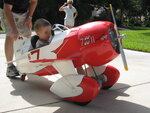- Thread starter
- #41
GregP
Major
I like the P-39. Nothing there that a decent turbocharger coudn't fix. The P-63 with the Aux stage Allison fixed it and flew quite well at the altitudes expected in the ETO. For some reason, we gave most of them to the Soviet Union. Go figure.
There were many prototypes that showed good promise, but the powers that be select only a few for production contracts. I believe the choice is mostly political, and not connected in any way with the needs of the service that will USE the planes. If THAT were not true, we wouldn't be flying F-35's today.
There were many prototypes that showed good promise, but the powers that be select only a few for production contracts. I believe the choice is mostly political, and not connected in any way with the needs of the service that will USE the planes. If THAT were not true, we wouldn't be flying F-35's today.
Last edited:

